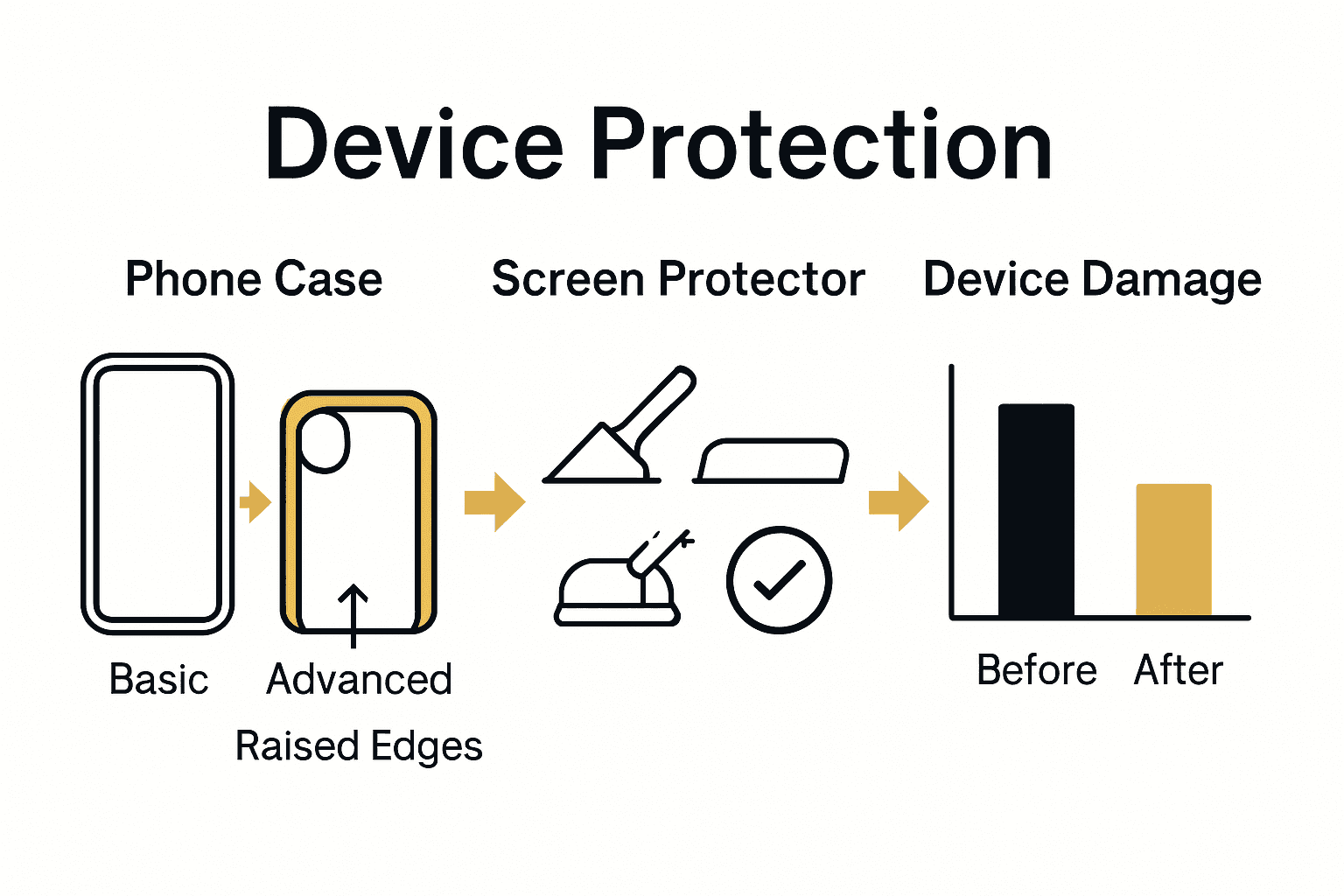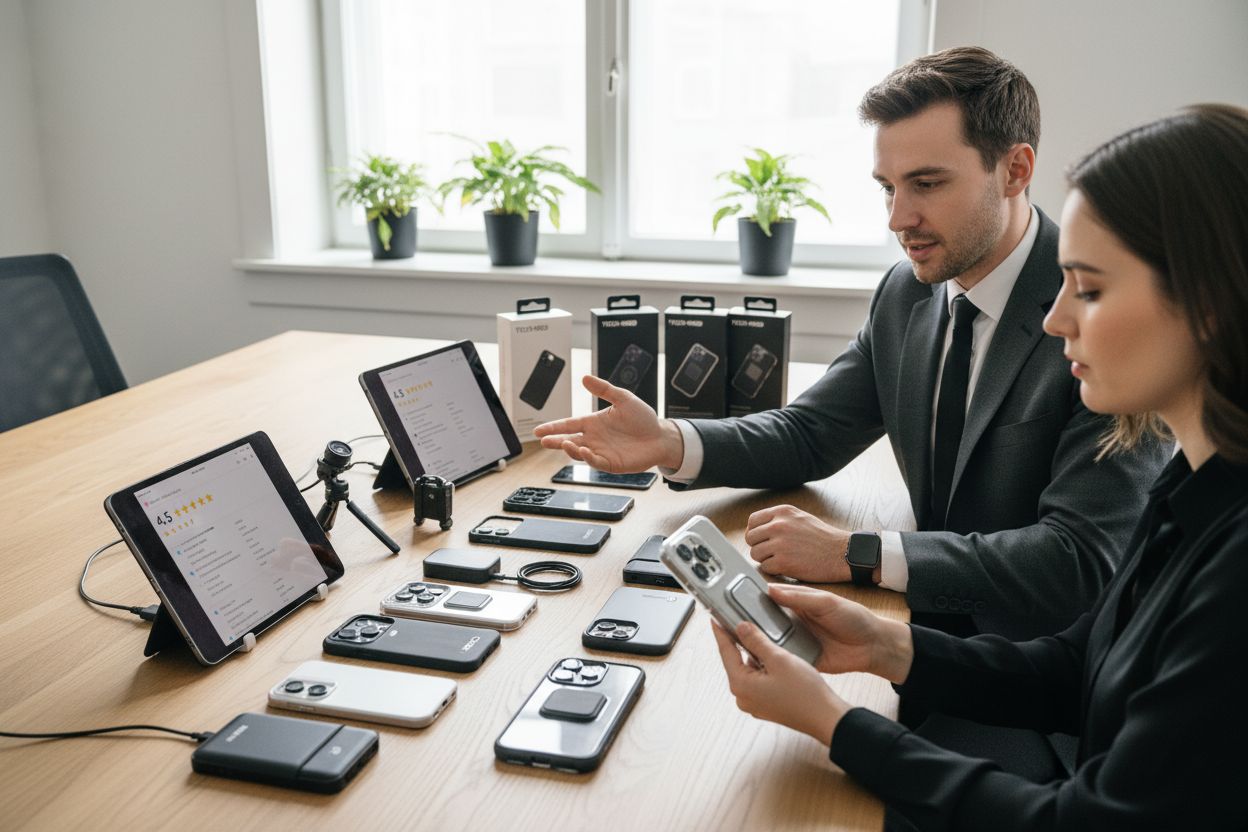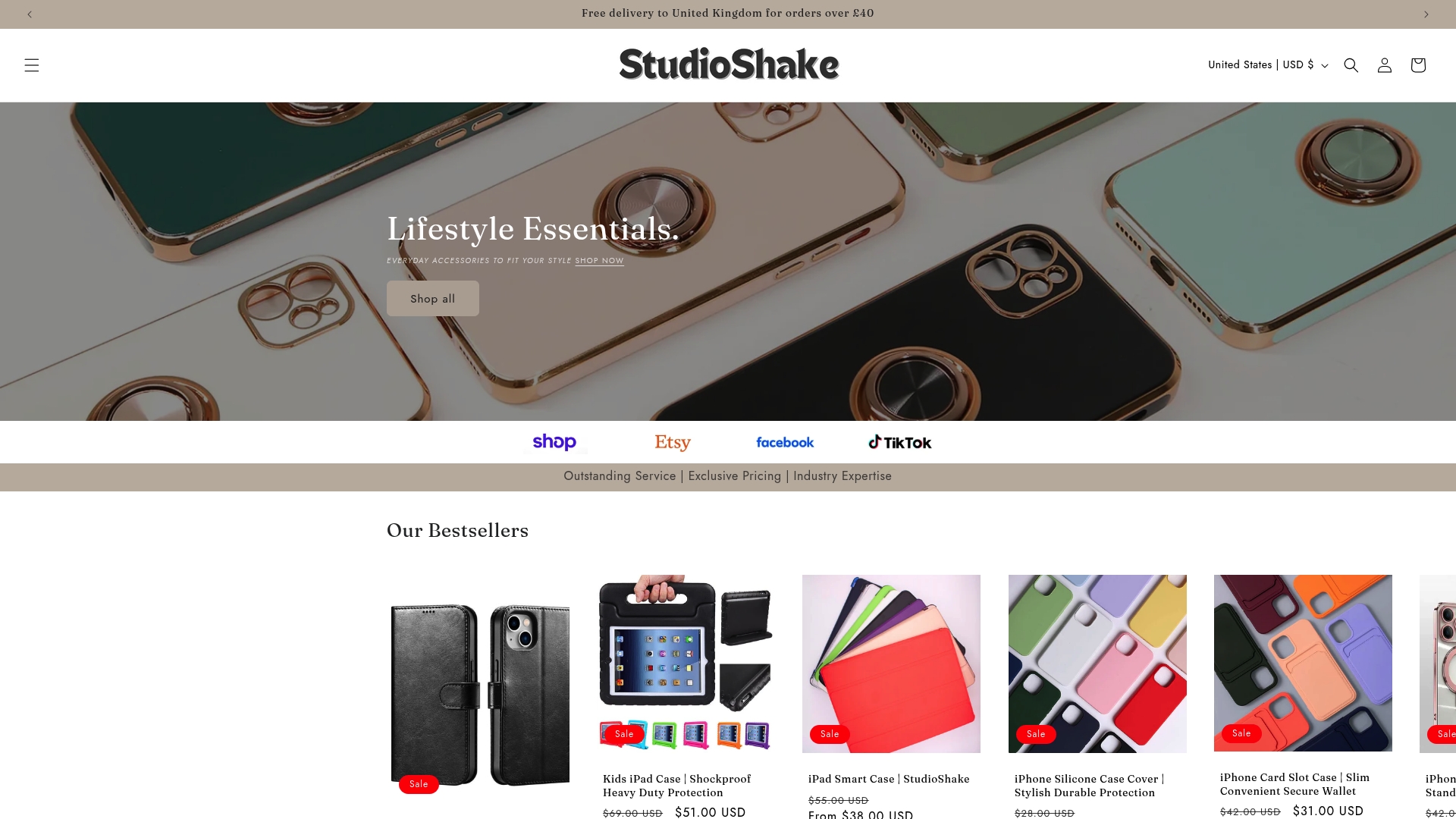
How to Upgrade Phone Accessories for Better Protection
Share
Did you know that over 60 percent of phone users have experienced screen or device damage due to inadequate protection? Every drop, bump, or spill can turn a sleek smartphone into a costly repair job. Upgrading your phone accessories not only brings peace of mind but can extend your device’s life and performance. Discover how a smart assessment of your current gear sets the foundation for better protection, fewer accidents, and features tailored to your lifestyle.
Quick Summary
| Key Point | Explanation |
|---|---|
| 1. Assess current accessories thoroughly | Examine existing cases and features to identify protection gaps vital for your device’s safety and personal needs. |
| 2. Research the latest accessory innovations | Investigate cutting-edge protective accessories that enhance both safety and functionality, ensuring compatibility with your device model. |
| 3. Prioritize high-quality screen protectors | Opt for 9H-hardness tempered glass protectors that meet safety standards and regularly replace them to maintain clarity and protection. |
| 4. Ensure proper installation of accessories | Follow precise procedures for installing screen protectors and cases to maximize effectiveness and maintain device functionality. |
| 5. Test functionality post-installation | Conduct tests for responsiveness, protection, and real-world usage to confirm that accessories function correctly without obstruction. |
Table of Contents
- Step 1: Assess Current Phone Accessories And Needs
- Step 2: Research Latest Accessories And Features
- Step 3: Select Suitable Upgrades For Your Devices
- Step 4: Install And Set Up New Accessories Properly
- Step 5: Test Functionality And Ensure Device Protection
Step 1: Assess Current Phone Accessories and Needs
Before upgrading your phone accessories, you need to conduct a thorough assessment of your current protective gear. This step helps you understand exactly what improvements will provide the most value for your device’s safety and your personal needs.
Start by carefully examining your existing phone case. According to local UK mobile repair experts, look for key protective features such as raised edges around the screen and camera. These elements are crucial for preventing direct impact damage during accidental drops. Check if your current case uses materials like TPU (thermoplastic polyurethane), which offers excellent shock absorption and can significantly reduce potential damage.
Here’s a comparison of key phone case features to consider during your assessment:
| Feature | Typical Basic Case | Advanced Protective Case |
|---|---|---|
| Material | Plastic Silicone |
TPU Polycarbonate Hybrid materials |
| Raised Edges | Not always present | Screen & camera edges elevated |
| Shock Absorption | Minimal | Enhanced drop resistance |
| Water Resistance | None | Some water-repellent coatings |
| Extras | Simple fit | Integrated stands Card slots Grip texture |
Next, evaluate your device’s water resistance rating. While many smartphones come with IP68 ratings, UK mobile repair experts recommend being mindful of real-world factors. Salt water, high humidity, and persistent moisture can compromise protection even on devices rated as water resistant. Your assessment should include checking for any existing wear and tear on current protective accessories.
Pro Tip: Inspect your screen protector carefully for any micro cracks or lifting edges that could compromise its protective capabilities.
Regarding screen protectors, be aware of safety regulations. Under UK consumer product safety law, these accessories must meet specific standards. Look for products that comply with the UK’s General Product Safety Regulations and have clear, safe labeling with accurate protection claims.
Your goal is to identify gaps in your current protection strategy. Are there specific scenarios where your existing accessories fall short? Perhaps you need better drop protection for outdoor activities or enhanced screen protection for work environments.

Ready to move forward? The next step will involve researching specific upgrade options that address the protection gaps you’ve just identified.
Step 2: Research Latest Accessories and Features
Now that you have assessed your current phone accessories, it is time to explore the cutting-edge world of mobile protection and functionality. This research phase will help you discover innovative accessories that can significantly enhance your device’s performance and safety.
Start by investigating the latest technological advancements in phone accessories. According to TechRadar, the mobile accessory landscape is evolving rapidly. For instance, Google’s Pixel 10 series now supports a Qi2-based magnetic accessory ecosystem called Pixelsnap, which enables MagSafe-style attachments. This means you can now find compatible chargers, stands, and rings that work seamlessly with your device.
Expand your research beyond charging solutions. The Verge highlights emerging trends like modular accessory systems. The Nothing Phone 2 Pro, available in Europe, offers an impressive range of customizable accessories including screw-on cases, kick-stand wallets, camera lens attachments, and lanyards. These options provide not just protection but also enhanced functionality tailored to your lifestyle.
Pro Tip: When researching accessories, prioritize compatibility with your specific device model to ensure optimal performance and fit.
Consider exploring accessories that offer multiple functions. Look for cases that provide not just drop protection but also integrate features like card storage, kickstands, or enhanced grip. Check reviews from tech enthusiasts and read user experiences to understand real-world performance.
Dont forget to compare prices and read detailed product specifications. Some accessories might look promising but fail to deliver quality protection or functionality. Take time to read expert reviews and user feedback to make an informed decision.
Ready for the next step? You will now evaluate which of these exciting new accessories best address the protection gaps you identified in your initial assessment.
Step 3: Select Suitable Upgrades for Your Devices
With your initial research complete, it is time to make informed decisions about upgrading your phone accessories. This step involves carefully matching new protective gear to your specific device requirements and usage patterns.
Start by focusing on screen protection. According to UK-accessible guidance, prioritize 9H-hardness tempered glass screen protectors. These are significantly more effective than thicker or softer alternatives. Make sure to match the protector design precisely to your phone’s screen type whether curved or flat.
When selecting screen protectors, pay close attention to regulatory compliance. Guidance from safety experts recommends checking for appropriate safety labelling, clear English instructions, and avoiding unsupported claims like military-grade protection. Ensure the product is free from hazardous chemicals and does not have sharp edges that could compromise safety.
Pro Tip: Replace your screen protector approximately every six months to maintain optimal protection and clarity.
Consider a holistic approach to protection. A high-quality screen protector works best when combined with a case that features raised edges. This combination provides comprehensive drop protection and minimises potential damage to your device.
Look beyond just protection and consider functionality. Some cases offer additional features like card storage, enhanced grip, or integrated kickstands. Choose upgrades that not only safeguard your device but also enhance your daily interaction with it.
Remember to verify compatibility with your specific phone model. An accessory that looks perfect might not fit or function correctly with your particular device. Read user reviews, check detailed specifications, and when possible, consult with the manufacturer or a trusted retailer.

Ready for the next phase? You will now move on to implementing these carefully selected upgrades and ensuring they provide the protection your device needs.
Step 4: Install and Set Up New Accessories Properly
You have carefully selected your new phone accessories and now comes the critical stage of installation. Proper setup is essential to ensure maximum protection and functionality for your device.
Mous UK provides expert guidance on installing screen protectors with precision. Begin by preparing a clean flat surface in a bright environment. Thoroughly clean your phone screen to remove any dust particles or oils that might interfere with adhesion. Use specialised dust removal stickers to eliminate tiny particles that could cause bubbles or imperfections.
For screen protector application, work methodically and carefully. Different protector types like TPU, tempered glass, or hybrid glass require slightly different approaches. The key is to align the protector precisely in one swift motion. Use an anti-bubble card wrapped in a microfibre cloth to gently push out any trapped air bubbles, ensuring a smooth and perfect fit.
Pro Tip: Apply screen protectors in a room with minimal air circulation to reduce dust interference during installation.
When installing phone cases, check for perfect alignment with ports and buttons. Ensure the case provides full access to all device functionalities without obstructing speakers, charging ports, or camera lenses. Some cases require a specific installation technique to prevent potential damage during fitting.
Take time to test the functionality of your new accessories immediately after installation. Check that wireless chargers connect properly, that phone cases allow smooth button press, and screen protectors do not interfere with touch sensitivity. Make small adjustments if needed to guarantee optimal performance.
Remember that patience during installation can prevent potential damage to your expensive device. If you feel unsure about any step, consider seeking help from a professional or the accessory manufacturer.
With your new accessories now properly installed, you are ready to enjoy enhanced protection and functionality for your mobile device.
Step 5: Test Functionality and Ensure Device Protection
With your new accessories installed, the final critical step is thoroughly testing their protection and functionality. This stage ensures your device remains safe and performs optimally under real-world conditions.
UK repair specialists recommend a comprehensive testing approach. Begin by checking touchscreen responsiveness immediately after installing your new screen protector. Verify that every tap, swipe, and gesture works precisely as before without any interference from the new protective layer.
Carefully inspect the interface between your case and screen protector, particularly if you have a curved screen device. Protection testing guidance suggests monitoring for potential edge lifting or gaps that could compromise overall device protection.
Pro Tip: Test your device’s water resistance by gently wiping it with a damp cloth and checking for any moisture ingress around the case edges.
Conduct practical durability tests by simulating everyday scenarios. Drop your phone carefully from a low height onto a soft surface to check case protection. Try charging wireless devices, connecting headphones, and accessing all ports to confirm your accessories do not obstruct functionality.
Remember that protection is an ongoing process. Plan to replace your screen protector approximately every six months or immediately after noticing any micro-cracks. Regular inspection helps maintain optimal device safety and prevents potential long-term damage.
Pay special attention to environmental factors. If you frequently use your device in humid environments, periodically check for signs of moisture or wear that might compromise your accessories protective capabilities.
You have now completed a comprehensive upgrade of your phone accessories with strategic protection in mind.
Choose Proven Protection for Your Phone Today
Have you discovered gaps in your current phone case or realised your accessories are not offering the robust defence you need? If your goal is maximum device safety combined with smart functionality, you deserve solutions curated for real-world protection. The article highlighted the importance of raised edges, durable materials, and precise fit to keep your device safe from daily knocks, moisture, and drops. At StudioShake, we understand the worry that comes with finding true peace of mind for your investment. That is why we offer a wide range of accessories designed especially for iPhone, Samsung Galaxy, and the latest technology. Each product ensures you never have to compromise on safety, comfort, or style again.

Take action now. Upgrade to expert-tested screen protection and cases that meet UK safety standards. Explore StudioShake and choose the right safeguard for your phone before damage happens. Shop today and experience confidence in every call, browse, and adventure your device takes.
Frequently Asked Questions
How do I assess my current phone accessories for better protection?
To assess your current phone accessories, examine your phone case for protective features like raised edges and material type. Look for signs of wear and ensure that your screen protector is free from micro cracks or lifting edges.
What features should I look for when upgrading my phone case?
When upgrading your phone case, prioritize materials that offer enhanced shock absorption, such as TPU or hybrid materials. Also, consider cases with raised edges for better screen and camera protection during drops.
How can I ensure I choose the right screen protector for my device?
To choose the right screen protector, check for compatibility with your phone model and look for a high hardness rating, like 9H. Make sure the product complies with safety regulations, and avoid unsupported claims like military-grade protection.
What steps should I follow to properly install my new phone accessories?
To properly install your new phone accessories, start by cleaning your phone screen thoroughly before applying the screen protector. Align the protector accurately in one swift motion, and use an anti-bubble card to remove any trapped air for a smooth finish.
How often should I test my phone’s protection after upgrading accessories?
After upgrading your accessories, test your phone’s protection regularly, ideally every month. Check touchscreen responsiveness and look for any signs of wear on your screen protector and case.
When should I replace my screen protector for optimal safety?
Replace your screen protector approximately every six months or immediately if you notice any micro cracks or lifting. Regular replacement ensures your phone stays protected from potential damage.
